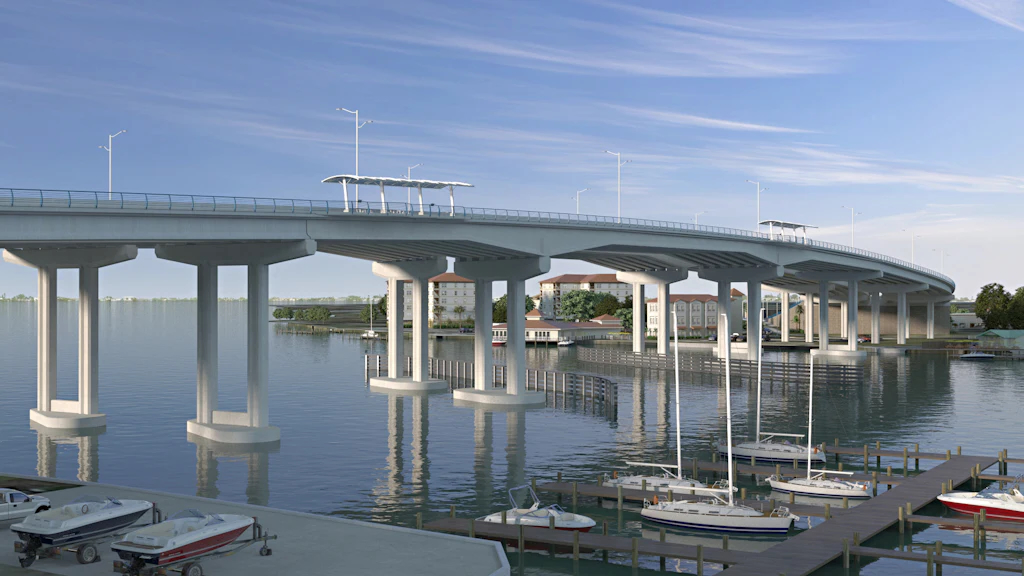Have a story idea
Have a story idea? Send it to us here.

Source : WSP
February 16, 2024
Author : Alex Bustillos
Florida's ambitious infrastructure endeavor, the new John T. Brooks Bridge construction, promises to set a new benchmark in bridge design and construction in the United States.
Spearheaded by the Florida Department of Transportation (FDOT), this $171 million project aims to replace the existing bridge that has connected Fort Walton Beach and Okaloosa Island since 1965.
Traffic on the four-lane U.S. 98 bridge across the Santa Rosa Sound and Intracoastal Waterway now averages 66,000 vehicles per day. It is also too shallow to accommodate larger vessels, and there have been frequent accidents. The new bridge will be 2,111 feet long, 793 feet longer than the current one.
The new state-of-the-art six-lane bridge caters to modern vehicular volumes, larger boats, and environmental conservation efforts.
The design-build team, comprising Superior Construction and engineering powerhouse WSP, plans to introduce a bridge that is wider, longer, and taller and incorporates a pioneering corrosion-resistant post-tensioning method. This technique, a first in the U.S., involves using unbonded flexible filler instead of the traditional grout for post-tensioning tendons, significantly enhancing the structure's resistance to the corrosive effects of a salty climate.
Central to the bridge's innovative design is replacing grout with wax within the ducts holding the post-tensioning tendons. This approach protects the tendons from corrosion, ensuring the bridge's longevity and structural integrity. WSP's project design manager, Matt Durshimer, highlighted the uniqueness of this method, noting its successful application in Europe and its potential to redefine construction standards in harsh environmental conditions.
Beyond its engineering marvels, the project is deeply committed to environmental stewardship. Special lighting designed to protect sea turtles, a critical consideration in Florida's sensitive coastal ecosystems, will be installed. This lighting will feature a low-intensity amber hue to prevent disruption to the turtles' nesting and hatching activities. Additionally, to mitigate the risk of damage from barges—a concern underscored by past incidents—the construction will utilize a trestle system rather than relying on barges, thereby enhancing the project's safety and resilience.
The new bridge's design also prioritizes community accessibility and environmental impact. Plans include biking and walking paths, scenic outlooks, shade structures, and enhanced drainage and intersection upgrades. Furthermore, the bridge will facilitate improved traffic flow and emergency evacuations, which are crucial for the safety and well-being of Okaloosa Island residents.
The bridge will be built in three phases, with the old bridge remaining open to traffic until the first two phases finish the westbound bridge. The old bridge will be removed after traffic moves to the new one. The third phase will construct the eastbound bridge.
Superior intends to build each end of the bridge simultaneously, working toward the middle and then returning to the ends to achieve the deadline. The new eastbound bridge will be built over the present bridge's footprint.
Blasting and full demolition are not planned because the new foundation is broader and longer than the current one; the existing foundations can be cut at the mud line.
The initial phase will be the most difficult since they must work within a restricted right of way roughly the same width as the cranes' tracks.
This comprehensive approach to bridge construction, blending innovative engineering solutions with environmental sensitivity and community-focused design, positions the John T. Brooks Bridge project as a pioneering model for future infrastructure projects. Slated for completion in August 2027, the bridge is expected to become an iconic structure for Fort Walton Beach and Okaloosa Island, symbolizing the harmonious integration of functionality, aesthetic appeal, and ecological consciousness.
Category : Department of Transportation Bridges
